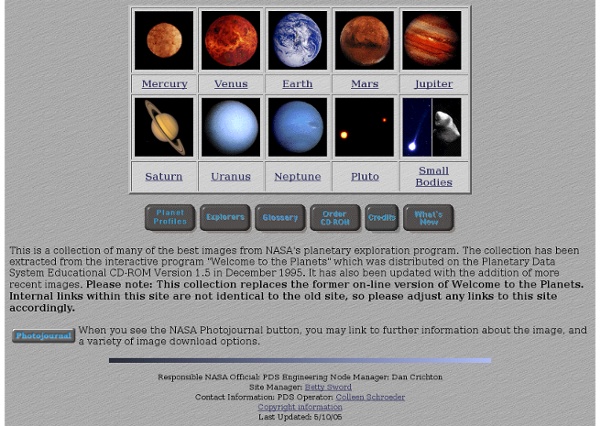



Solar System, Solar System Information Our Cosmic Neighborhood From our small world we have gazed upon the cosmic ocean for thousands of years. Ancient astronomers observed points of light that appeared to move among the stars. They called these objects "planets," meaning wanderers, and named them after Roman deities—Jupiter, king of the gods; Mars, the god of war; Mercury, messenger of the gods; Venus, the goddes of love and beauty, and Saturn, father of Jupiter and god of agriculture. Since the invention of the telescope, three more planets have been discovered in our solar system: Uranus (1781), Neptune (1846), and, now downgraded to a dwarf planet, Pluto (1930). The four planets closest to the sun—Mercury, Venus, Earth, and Mars—are called the terrestrial planets because they have solid rocky surfaces. Nearly every planet—and some of the moons—has an atmosphere. Moons, Rings, and Magnetospheres From 1610 to 1977, Saturn was thought to be the only planet with rings. —Text courtesy NASA/JPL
ΝΙΚΟΣ ΛΑΜΠΡΙΝΟΣ ΓΕΩΓΡΑΦΙΑ ΚΑΙ ΕΚΠΑΙΔΕΥΣΗ Καλώς ήρθατε στην ιστοσελίδα της Γεωγραφίας για εκπαιδευτικούς και μαθητές Η ιστοσελίδα αυτή κατασκευάστηκε με σκοπό να προσφέρει στους εκπαιδευτικούς μία εύκολη και ανέξοδη διέξοδο στο πρόβλημα που καθημερινά συναντάνε από την έλλειψη εκπαιδευτικών υλικών στο μάθημα της Γεωγραφίας Δεν φιλοδοξεί να αντικαταστήσει τις όποιες άλλες πηγές - βοηθήματα Γεωγραφίας που υπάρχουν αλλά, να τις συμπληρώσει Στην ιστοσελίδα θα βρείτε χάρτες τις Ελλάδας που καλύπτουν διάφορα θέματα, χάρτες διαφόρων νομών, τρισδιάστατες απεικονίσεις και εικονικές πτήσεις σε αρχεία μορφής avi. Ανανεώσεις Σκοπός μας είναι να εμπλουτίζουμε την ιστοσελίδα συνέχεια με νέους χάρτες και άλλο βοηθητικό υλικό. Το υλικό που παρουσιάζεται έχει κατασκευαστεί ή επεξεργαστεί στην αίθουσα Γεωγραφίας του Παιδαγωγικού Τμήματος Θεσσαλονίκης Ελπίζουμε και στη δική σας συμβολή γαι να γίνει ακόμη πιο χρηστική. Λαμπρινός Νίκος© 2003 | All Rights Reserved
Planets - Zoom Astronomy Advertisement. EnchantedLearning.com is a user-supported site. As a bonus, site members have access to a banner-ad-free version of the site, with print-friendly pages.Click here to learn more. (Already a member? Click here.) The Planets (plus the Dwarf Planet Pluto) Our solar system consists of the sun, eight planets, moons, many dwarf planets (or plutoids), an asteroid belt, comets, meteors, and others. The eight planets that orbit the sun are (in order from the sun): Mercury, Venus, Earth, Mars, Jupiter, Saturn, Uranus, Neptune. Easy ways to remember the order of the planets (plus Pluto) are the mnemonics: "My Very Excellent Mother Just Sent Us Nine Pizzas" and "My Very Easy Method Just Simplifies Us Naming Planets" The first letter of each of these words represents a planet - in the correct order. The largest planet is Jupiter. The inner planets are: Mercury, Venus, Earth, and Mars. Generally, the farther from the Sun, the cooler the planet. Density of the Planets The Mass of the Planets
Earth from Space The NASA Earth Observations Photography database of images is a national treasure. We are publishing these selected photos and related captions on the Internet to provide a glimpse of this national treasure to the public. This database was compiled by our staff to illustrate some very interesting Earth features and processes, including cities as seen by our Astronauts from space. Earth from Space provides several ways to search the selected images. The information contained in this collection is for informational purposes only and does not constitute official NASA positions or statements. Γεωδρόμιο... | ένα ταξίδι στον κόσμο με γεωγραφικές διαδρομές και εκπαιδευτικές δραστηριότητες
Solar System Discovery and exploration Andreas Cellarius's illustration of the Copernican system, from the Harmonia Macrocosmica (1660) For many thousands of years, humanity, with a few notable exceptions, did not recognize the existence of the Solar System. Structure and composition The orbits of the bodies in the Solar System to scale (clockwise from top left) The principal component of the Solar System is the Sun, a G2 main-sequence star that contains 99.86% of the system's known mass and dominates it gravitationally.[13] The Sun's four largest orbiting bodies, the gas giants, account for 99% of the remaining mass, with Jupiter and Saturn together comprising more than 90%. Most large objects in orbit around the Sun lie near the plane of Earth's orbit, known as the ecliptic. The overall structure of the charted regions of the Solar System consists of the Sun, four relatively small inner planets surrounded by a belt of rocky asteroids, and four gas giants surrounded by the Kuiper belt of icy objects.
Kids Homework Help K-4 Kids Do It Yourself Games Select an Inner Planet ΠΡΙΝ ΤΟ ΣΕΙΣΜΟ Αγγελόπουλος Απόστολος 19ο Δημοτικό Σχολείο Βόλου Τι πρέπει να κάνετε ΑΠΟ ΤΩΡΑ Συζητήστε με την οικογένειά σας και καταστρώστε σχέδιο έκτακτης ανάγκης. Όλα τα μέλη της οικογένειας πρέπει να γνωρίζουν τι να κάνουν σε περίπτωση σεισμού. Προγραμματίστε που θα καταφύγετε μετά το σεισμό. Βοήθησε το Θαλή να ψωνίσει τα απαραίτητα , ώστε να είναι προετοιμασμένος σε περίπτωση σεισμού. Προσπάθησε να βάλεις τα διάφορα αντικείμενα των δωματίων στη σωστή τους θέση , ώστε να μην κινδυνέψεις σε περίπτωση σεισσμού.